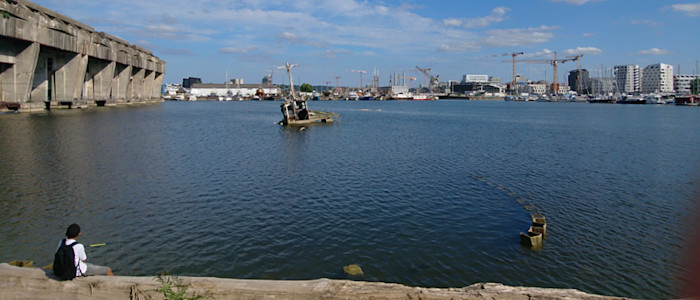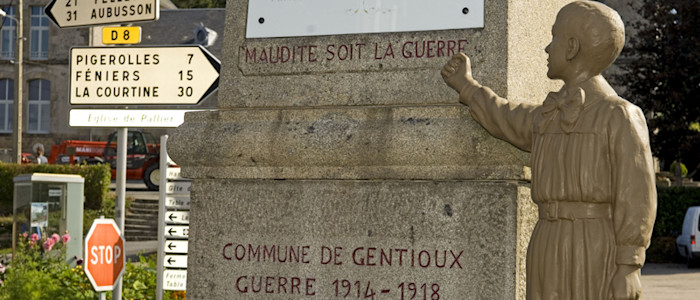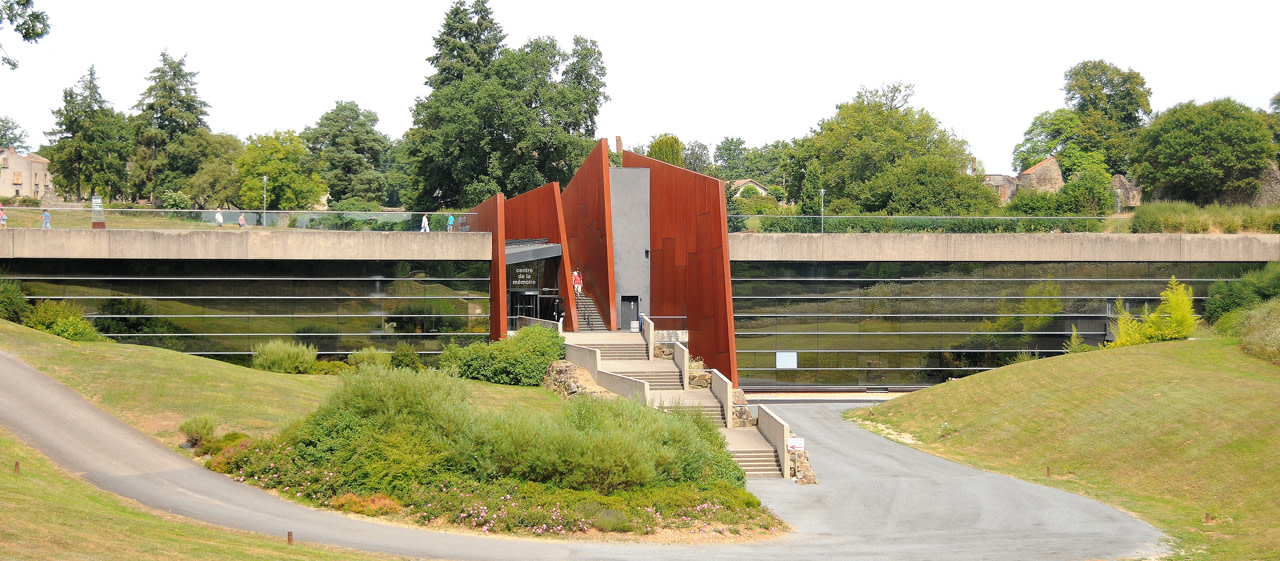1. Le Centre de la mémoire d'Oradour-sur-Glane

1. The Oradour-sur-Glane Memorial Centre
The village of Oradour-sur-Glane, 22 kilometres north-west of Limoges, is tragically famous for the massacre of its 642 men women and children by a unit of the 2nd Waffen SS Panzer Division Das Reich on 10 June 1944.
Declared an historic monument in 1946, the ruins of the village are now visited by around 300,000 people every year. They are accompanied by the Memorial Centre with its sensitively designed historic journey of interpretation and education.
[www.oradour.org](http://www.oradour.org
Open every day from 1 February to 15 December inclusive.
Entrance: from €5.20, with special rates for groups.
2. La Base sous-marine de Bordeaux

2. The Bordeaux Submarine Base
The Bordeaux submarine base is one of five constructed on the Atlantic coast to house the German and Italian submarine fleets during the Second World War. Today, it is an arts centre for contemporary creativity.
www.bordeaux-tourisme.com
Opening times: Tuesday to Sunday from 1:30 pm to 7 pm
Closed Mondays and public holidays. Entrance from €3, with free entry on the first Sunday of each month
3. Le Musée de la Résistance de Limoges
3. The Limoges Resistance Museum
The museum-format trail of this 1,400 m² cultural centre retraces the key moments of the Second World War, with particular focus on the French Resistance, the occupation of Haute-Vienne and the associated deportations.
Its purpose is to keep the memory alive by providing an educational and informative resource, especially for younger people.
www.resistance-massif-central.fr
Opening times: every day (except Tuesday and Sunday mornings). Guided tours available for advance bookings.
4. Le Bunker de La Rochelle
4. The La Rochelle Bunker
The Musée Rochelais de la Dernière Guerre is housed in an original former bunker constructed during the 1939-1945 conflict as accommodation for the U-Boot commanders of submarines stationed in the La Rochelle Submarine Base.
The La Rochelle Bunker retraces the occupation of the city of La Rochelle and its surrounding area between 1939 and 1945. The collection includes objects, photographs, documents and videos.
Open from February to December, but closed every January. Entrance: from €5.50
5. Le Musée de la Résistance de Peyrat-le-Château
5. The Peyrat-le-Château Resistance Museum
The Peyrat-le-Château Resistance Museum is 50 km east of Limoges. Its three exhibition spaces examine the secret network of resistance fighters known as the maquis, the role paid by women in the Resistance, the massacres at Tulle and Oradour-sur-Glane, and the liberation of Limoges. The museum tour is complemented by Première Brigade, the documentary film by François Perlier featuring personal recollections by the maquis companions of Georges Guingouin (France’s leading resistance fighter).
Opening times: 15 June to 15 September from Tuesday to Sunday between 2:30 pm and 5:30 pm.
Guided tours are available for groups all year round for advance bookings. Entrance: €3:50 per person. Free for children under 12.
6. Le Mémorial de la Résistance de Chasseneuil-sur-Bonnieure
6. The Chasseneuil-sur-Bonnieure Resistance Memorial
37 km from Angoulême in Charente, the Chasseneuil-sur-Bonnieure Resistance Memorial was built in memory of the 1,465 martyrs of the French Resistance of the Charente and Charente-Maritime, and their fallen soldiers of the Second World War. It is both a Resistance Memorial and a national war grave.
www.cheminsdememoire.gouv.fr
Entrance is free.
7. Le Cimetière des gueules cassées de Cadillac
7. The Cimetière des Gueules Cassées in Cadillac
At the heart of the Sauternais winegrowing area 40 km south of Bordeaux, the ‘Cemetery of the Forgotten” - also known as the ‘Lunatics Cemetery’ - is attached to the former psychiatric hospital that once cared for 98 war veterans with severe facial and brain injuries: the so-called “Gueules cassées” of the First World War.
Entrance is free.
8. Le Camp d’internement de Gurs en Béarn
8. The Gurs internment camp
The internment camp at Gurs in Béarn, 40 km from Pau and 5 km from Navarrenx, was one of the largest in France. At 2 km long and 500 metres wide, its 13 blocks of 400 barracks were built to house those fleeing combat in Spain (Spanish Republicans and International Brigade fighters) after General Franco seized power, as well as Communists and other ‘undesirables’. Of the 64,000 or so people interned here, 1,072 died between March 1939 and August 1944 when the camp was closed following the Liberation of Paris. A national memorial was built here in 1994 alongside the railway track that remains as a lasting symbol of the deportations.
Entrance is free.
9. Le Centre Régional Résistance et Liberté de Thouars
9. The Resistance & Freedom Regional Centre at Thouars
Located in Deux-Sèvres, 70 km from Poitiers and 80 km from Niort, the Resistance & Freedom Regional Centre is a cultural and educational centre designed to perpetuate the values of the French Resistance, citizenship and solidarity. This innovative facility focuses on the events of the Second World War and the Regional Resistance Fighters and their achievements during the period 1933 to 1945 so that everyone ‘understands their freedom and perpetuates it’.
www.crrl.fr
Opening times: 6 February to 31 March, Tuesday to Friday between 2:30 pm and 6 pm. 1 April to 30 September from Tuesday to Sunday between 2:30 pm and 6 pm. Closed public holidays.
Groups (min. 10 visitors): every day between 9 am and 6 pm by advance booking.
Closed every year during the Christmas school holidays.
Entrance: from €2, and free for children under 12.
10. Le centre d’études et musée Edmond Michelet de Brive-la-Gaillarde
10. The Edmond Michelet Study Centre & Museum at Brive-la-Gaillarde
This building is both a documentation centre and archive containing the personal documents of politician and resistance leader Edmond Michelet, and a museum open to the public. The nine exhibition spaces are designed to introduce visitors to different aspects of the Second World War years: the Resistance and Deportation, the Vichy government and its propaganda through imagery, daily life during the Occupation and the Liberation of Brive.
The museum has a remarkable collection of more than 400 French language propaganda posters from the Second World War.
http://centremichelet.brive.fr
Opening times: 1 October to 30 April, from Monday to Saturday between 1 pm and 6 pm. Closed on public holidays and between Christmas and New Year.
2 May to 30 September, from Monday to Friday between 11 am and 6 pm, and Saturday between 1 pm and 6 pm. Closed public holidays (except 15 August)
Entrance is free.
11. Monument aux morts de Gentioux-Pigerolles

11. The Gentioux-Pigerolles war memorial
"Damn the War" claims a clog-shod schoolboy clutching his cap. His fist is outstretched towards the 58 names carved into the memorial tablet, symbolising the pain and revolt after the loss of a father in the First World War.
Erected in 1922 at Gentioux-Pigeolles in the Creuse department (30 km from Aubusson), this war memorial has become a traditional rallying point for pacifists denouncing the absurdity of war every Armistice Day.
It has been a Listed Historic Monument since 1990.





